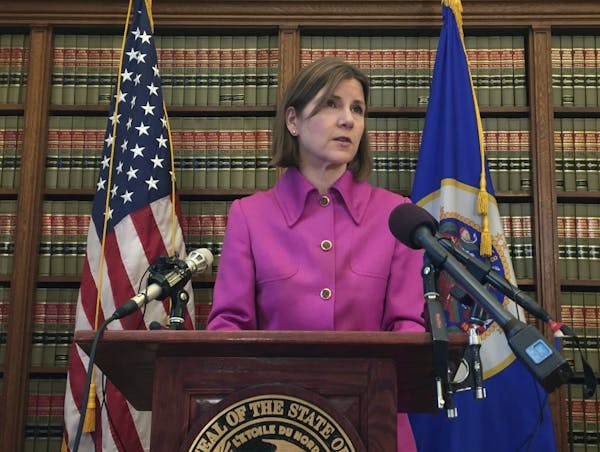Minnesota's individual health insurance market isn't what it used to be, but after three years of declines health plans are cautiously optimistic it won't shrink any further in the coming year.
Open enrollment for individual plans, including those sold on the state's MNsure exchange, starts Wednesday.
When major reforms kicked in with the federal Affordable Care Act, about 300,000 state residents were covered by individual health plans — a small slice of Minnesota's population that's even smaller now, with about 166,000 people buying the coverage as of April.
The sign-up tally is important for the long-term stability of the market, which has been plagued since 2014 by big premium jumps and significant changes in the lineup of health plans being sold.
"I think there are some headwinds that will keep people from buying insurance," said Jim Schowalter, chief executive of the Minnesota Council of Health Plans, a trade group for insurers. "But with reinsurance and stable premiums, a few people might be coming back, too."
The individual market primarily serves people under age 65 who are self-employed or don't get health insurance from their employer or the government. The market has undergone major changes since 2014 with the Affordable Care Act (ACA), which launched the MNsure exchange and brought federal tax credits for many who buy the coverage.
Earlier this year, state lawmakers pledged $271 million for a reinsurance program in 2018 that serves as a financial cushion for insurers that cover individuals with unusually large medical bills. The program is lowering individual premiums by 20 percent from where they otherwise would be.
The premium for the benchmark silver health plan available through MNsure for a 40-year-old in the Twin Cities will decline next year by 11 percent to $327 per month in Hennepin County. In Rochester, a 40-year-old buying the benchmark plan will see premiums increase 7 percent to $596 per month.
While many counties across the country will see a dwindling roster of insurance companies selling individual coverage next year, the number of carriers in Minnesota is holding steady for most counties. What's more, whereas enrollment caps in Minnesota on most plan options for 2017 created a sense of urgency for consumers to buy plans as soon as possible last year, there's not the same pressure this year.
Four of five carriers in the individual market will have enrollment caps, but regulators don't expect any insurers actually will hit the limits. And Minnetonka-based Medica, which is the only carrier selling individual market plans statewide, won't have a cap for 2018.
"With relative rate stability and no large changes to carriers/service areas for 2018, we expect enrollment to stay pretty flat and hopefully improve slightly in 2018," said Geoff Bartsh, a vice president with Minnetonka-based Medica, via e-mail.
Eagan-based Blue Cross and Blue Shield of Minnesota issued a statement saying: "We're seeing encouraging signs of stability in the individual market and are cautiously optimistic that trend can continue in 2018."
Just more than half of all Minnesotans buying individual plans this year are doing so through MNsure, where state officials are projecting modest enrollment growth for 2018. People at certain income levels who buy through MNsure can tap federal tax credits that discount premium costs.
MNsure said it will have additional contact center agents and phone lines during open enrollment.
The start of last year's sign-up period was marred by alleged "robocallers" jamming the phone lines at the health exchange, which also experienced a temporary website outage. State officials have repeatedly pledged over the past year that they have taken steps to prevent a repeat of the problems.
MNsure is offering new features to users including callbacks for people who would rather not hold on the phone for assistance. There's also a new online feature for people to view their enrollment status.
The MNsure website and call center will open Wednesday at 8 a.m.
Spending by MNsure on ads and consumer helpers known as "navigators" is holding steady this open enrollment period. The federal government, by contrast, is cutting spending on both types of outreach efforts.
"We've got the reins here at the local level, so we are serving Minnesotans in a different way than the federal government is right now," said Allison O'Toole, the MNsure chief executive, during an October interview. Citing the reinsurance program, O'Toole added: "The stars are sort of aligning for Minnesota right now."
Outreach efforts are important when it comes to health insurance, because it's "a product that is sold and not bought," said Deep Banerjee, a director at S&P Global Ratings. Young and healthy consumers who are needed for a balanced insurance risk pool also are the consumers who have to be persuaded to spend money on coverage, Banerjee said.
In an October report, S&P projected that enrollment nationwide through the ACA exchanges would be down by 7 percent to 13 percent compared to last year's open enrollment period. But analysts said they aren't overly concerned about the decline, since federal tax credits mean most consumers in the market likely will stick with it.
"The reason we don't think it's 'game over' is because, in every state there is kind of a floor to the market," Banerjee said. "You will never be in a situation where the market drops 50 percent in a single year, because there is that advance premium tax credit. That really is the key."
Insurance agents worry, however, about shoppers in Minnesota with incomes that are too high for tax credits. In 2017, those consumers are being helped by one-time rebates from the state government that will click off in January.
"For the people whose 25 percent subsidy disappears, they're not feeling the stability," said Heidi Michaels, executive director of the Minnesota Association of Health Underwriters, a trade group for insurance agents.
Christopher Snowbeck • 612-673-4744
Twitter: @chrissnowbeck
